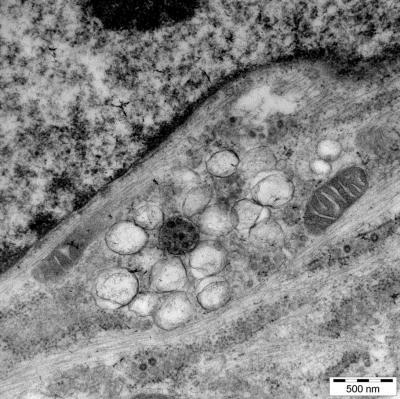Since the SARS epidemic in 2003, coronaviruses have been on the watch list for emerging pathogens, and the ongoing outbreak of Middle East respiratory syndrome coronavirus (MERS-CoV) confirmed that they represent a serious threat. No specific drugs exist against coronaviruses so far, but an article published on May 29th in PLOS Pathogens introduces a new inhibitor of coronaviruses and implicates a specific process in the life cycle of these viruses that it blocks.
Searching for inhibitors of coronaviruses, an international team of scientists led by Edward Trybala, from the University of Gothenburg, Sweden, and Volker Thiel, from the University of Berne, Switzerland, identified a compound called K22. They initially discovered that K22 had antiviral activity against a relatively harmless coronavirus that causes mild cold-like symptoms in humans. Follow-up experiments showed that the compound was effective against all other coronaviruses tested, including the SARS and MERS coronaviruses. The researchers also demonstrated efficient inhibition of virus in cells that line the human airways and are the natural port of entry for respiratory viruses.
Examining K22's mechanism of action, they discovered that the compound acts at an early step during the production of coronavirus in human host cells. Human cells are subdivided into different "compartments", for example the nucleus that contains the genetic information, or the mitochondria, which are the cell's power plants. Each compartment is surrounded by a wall-like structure called a "membrane". In order to multiply (i.e. manufacture new virus) and spread the infection, coronaviruses need to usurp and re-shape some of the membranes in the human host cells to build a sort of scaffolding for their virus production machinery. The results here show that K22 inhibits coronaviruses by preventing this use of host membranes for viral production.

This image shows a cluster of vesicles made by virus from usurped and reshaped membranes.
(Photo Credit: Volker Thiel, Edward Trybala, and colleagues)
"The remarkable efficacy of K22-mediated inhibition of coronavirus replication", the authors say, "confirms that the employment of host cell membranes for viral RNA synthesis is a crucial step in the coronavirus life cycle, and importantly, demonstrates that this step is extremely vulnerable and also druggable for antiviral intervention" Because the identification of K22 and its proposed mode-of-action is only the first, preclinical, step towards a therapeutic use, they also argue that "one important lesson of the past SARS and recent MERS coronavirus outbreaks is the need to invest significant efforts to developing efficacious and approved drugs to increase preparedness and combat coronavirus infections".
Source: PLOS